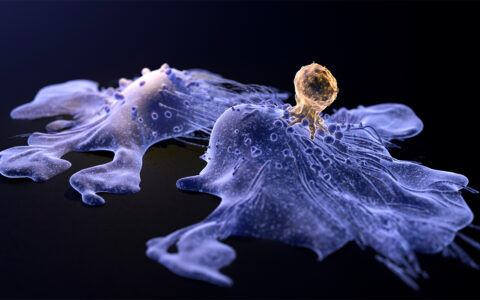The uncontrolled growth of a cancer cell not only requires that the cell cycle be left unchecked, but that protein synthesis and metabolic processes occur at a rapid clip. One protein linked to all of these activities is the oncoprotein transcription factor, MYC. Estimates suggest that one-third of all cancer deaths can be attributed to aberrant MYC expression or activity.
“Even in cancers where MYC is not the primary oncogenic lesion, if you inactivate MYC in those cancers, they tend to regress,” said William Tansey, Ph.D., Ingram Professor of Cancer Research at Vanderbilt University. “MYC is really high-up in the scheme of events that cells use to regulate their growth.”
Tansey is a senior author on a recent study published in the Proceedings of the National Academy of Sciences revealing that the interaction between MYC and its cofactor, WDR5, is essential for tumor maintenance. The findings suggest that if inhibitors can be developed that disrupt the MYC-WDR5 interaction, they may be widely successful anticancer agents.
MYC: The “Undruggable” Target
The direct targeting of MYC has been a coveted challenge. Tansey explains that the transcription factor is overexpressed in the majority of cancers, that high MYC expression is commonly associated with poor patient outcomes, and that experimental inactivation of MYC elicits tumor regression.
“It’s considered a high-value target for anti-cancer therapies…if you can find ways to target it,” Tansey said.
“If you’re going to go after something with small molecules, those drugs need to be directed towards structured regions of the protein.”
The challenge lies in the fact that MYC is an intrinsically disordered protein. “If you’re going to go after something with small molecules, those drugs need to be directed towards structured regions of the protein,” Tansey said. “MYC doesn’t have any of those.”
There are parts of MYC that do assume structure when in complex with other macromolecules. For example, MYC can bind to another unstructured protein, MAX, and when complexed together the two resemble a pair of scissors that wedges into the major groove of DNA.
Tansey says that, historically, the MYC-MAX interaction has been the main way people have been thinking about inhibiting MYC. However, the protein-protein interface connecting MYC and MAX is really large, making it difficult to disrupt with a small molecule.
“I think it’s generally agreed upon that MAX would probably be the best way to target MYC,” Tansey said. “I think it’s also agreed upon that the way in which drugs are discovered – in particular, the way in which they are turned from leads in these screens into drugs – it’s just not likely to work for MAX.”
WDR5: The Essential Sidekick
In the new study, Tansey and colleagues, including Stephen Fesik, Ph.D., Orrin H. Ingram II Chair in Cancer Research at Vanderbilt, report on the effectiveness of inhibiting MYC by targeting its well-structured cofactor, WDR5.
“To form a DNA binding module, MYC requires MAX. But that is not enough to get MYC to its target genes in the context of chromatin,” Tansey said. “For MYC to bind chromatin, it needs WDR5 to recruit it there.” The research team previously showed that MYC and WDR5 colocalize on chromatin, and that mutations in MYC that disable the interaction with WDR5 prevent MYC from binding chromatin and from initiating tumorigenesis.
In the new study, the researchers used CRISPR to engineer a Burkitt’s lymphoma cell line enabling the real-time replacement of wildtype MYC for mutants, and then used it to show that disrupting the MYC-WDR5 interaction within an existing tumor promotes tumor collapse. “We inject those cells into mice, and they form a tumor. And once the tumor is formed, we flip out the wildtype version of MYC for a version that does not bind WDR5, and the tumor regresses,” Tansey said.
“This validates the MYC-WDR5 interaction as being a viable point for therapeutic intervention. Our previous work indicates that the MYC-WDR5 interaction is required to make a tumor, but that’s not really relevant because people present with tumors.”
The study also revealed that the MYC-WDR5 interaction is essential for MYC to bind to and regulate genes involved in tumor protein synthesis.
Developing Inhibitors
Tansey says that the excitement about the WDR5 discovery is based on the fact that it takes some of the burden of drug discovery for MYC away from MYC and onto WDR5.
In separate studies, Tansey and Fesik have identified small molecule inhibitors of two specific sites on WDR5. One small molecule in particular, which targets the “WIN” site, has been shown in cell culture to displace WDR5 from chromatin, and this new study finds that it also displaces MYC from chromatin.
“What we’re trying to do now is double down to see if we can use WIN site inhibitors as anti-MYC therapies,” Tansey said. “We have really good molecules against these sites, and they are moving forward as part of the National Cancer Institute’s Experimental Therapeutics Program.”





